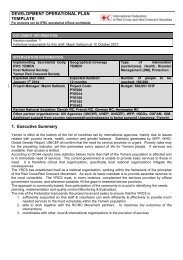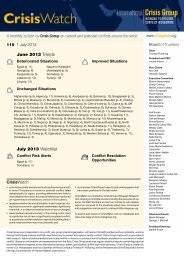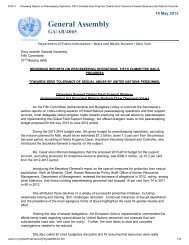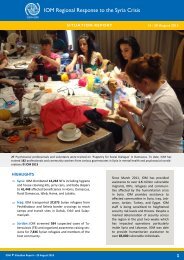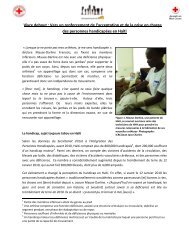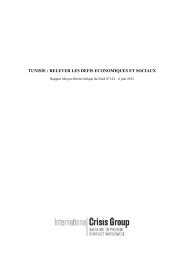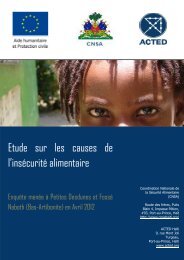SOMALI NUTRITION STRATEGY 2011 – 2013 - ReliefWeb
SOMALI NUTRITION STRATEGY 2011 – 2013 - ReliefWeb
SOMALI NUTRITION STRATEGY 2011 – 2013 - ReliefWeb
Create successful ePaper yourself
Turn your PDF publications into a flip-book with our unique Google optimized e-Paper software.
Management of malnutrition also involves its prevention. As highlighted in the section on outcome<br />
2, behaviour change communication strategies to improve complementary feeding practices have<br />
been proven effective in improving growth outcomes in young children. However, as the Lancet<br />
series on undernutrition concluded, such strategies alone were of most benefit in populations<br />
that had sufficient means to procure appropriate food. In food insecure populations, nutrition<br />
education had a greater impact when food or food supplements were provided. Furthermore, the<br />
recent review of complementary feeding (Dewey and Adu-Afarwuah 2008) found that interventions<br />
in which micronutrient supplementation alone was provided generally had little or no effect on<br />
growth.<br />
61<br />
This strategy includes key outputs for addressing longer term goals of improving diet diversity and<br />
increasing consumption of local nutrient dense foods. However, in the meantime the evidence<br />
cited above underscores the importance of providing food based interventions to meet energy<br />
and protein, as well as micronutrient, requirements for the prevention of undernutrition in high<br />
risk areas of food insecurity in Somalia. In these areas where locally available foods alone will<br />
not satisfy nutritional requirements, additional food products can fill a critical gap in nutrients as a<br />
complement to continued breastfeeding and the local diet, not as a replacement. Thus food based<br />
interventions will be accompanied by counselling on continued breastfeeding, responsive feeding<br />
and good hygiene practices.<br />
The review by Dewey and Abu-Afarwuah (2008) also found that in several studies the impact<br />
of providing a complementary food in combination with nutrition education was evident only in<br />
the younger children. This reiterates the ‘critical window of opportunity’ and the importance of<br />
targeting food based interventions to prevent undernutrition in the 6 to 24 months age group.<br />
In Somalia the options for products for<br />
food based interventions are corn soy<br />
blend (CSB) or the new lipid-based<br />
nutrient supplements (LNS). LNS are a<br />
range of products fortified with multiple<br />
micronutrients and in which lipid is the<br />
primary source of energy. There are<br />
pros and cons to both types of products.<br />
Blended food has long been used in<br />
Somalia. Its acceptability is proven, it<br />
is cheap and there are limited pipeline<br />
issues. On the negative side, the efficacy<br />
of blended food has more recently been<br />
questioned with varied results achieved.<br />
The energy density of blended food is low<br />
Child eating Plumpydoz, IDP camp Jowhar, UNICEF<br />
Somalia<br />
compared to the stomach capacity of a small child. The high phytate content of the current CSB<br />
inhibits micronutrient absorption while there is a lack of animal protein. Furthermore there are two<br />
factors of the Somali context which further reduce the efficacy of CSB. Firstly, it is rarely possible<br />
to premix blended food with oil and sugar therefore energy density is compromised. Secondly,<br />
limited supervision is possible and weak supervision has been demonstrated to reduce success<br />
(Navarro-Colorado et al 2008)). In addition, a recent review article found evidence of the efficacy of<br />
fortified blended foods for improving nutritional outcomes to be currently limited and weak (Perez-<br />
Exposito and Klein 2009). Two new products under development, CSB+ (pregnant & lactating<br />
women, children 2-5 years) and CSB++ (children under two), may improve the effectiveness of<br />
blended food in the future.




